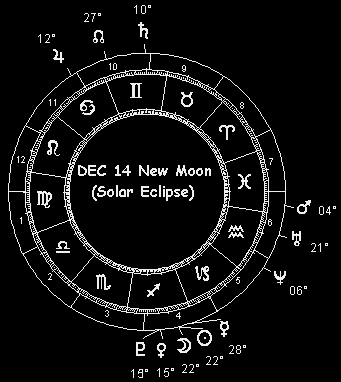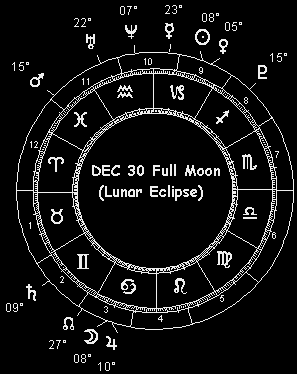If you were expecting some kind of sun sign nonsense, forget it. This is real astrology. See the section above. Please note: this forecast is expressed in terms of Universal Time (UT).
 December opens up still very much in the eddy of the full moon turbulence that closed out November. This lets up briefly a day after the Moon reaches maximum northern declination on the 3rd. But until then, storms and seismic action are likely to be running strong.
December opens up still very much in the eddy of the full moon turbulence that closed out November. This lets up briefly a day after the Moon reaches maximum northern declination on the 3rd. But until then, storms and seismic action are likely to be running strong.
Alignments from the faster moving Sun and inner planets to slower moving Saturn and Pluto - the latter pair still within five degrees of exact apparent opposition through the 16th - point to continued shakiness on the economic front in early December. Even the economies of the rich and powerful nations of the world remain vulnerable during this period, and the equity markets are bound to reflect this: up one day or two, then down a day or two, trading within a range but not breaking out yet. Investors are apt to gain some confidence in the second half of the month, after a fairly continuous battering in the first half. But with Saturn's opposition to Pluto still an unfinished story - thanks to the heliocentric alignment at the end of March and the final geocentric pass in May - the world financial system remains vulnerable well into 2002. Which is probably why any late December attempt at a rally turns into profit taking by New Year's Eve - or runs afoul of fear-mongering, military clashes and terrorist strikes.
Reaching perigee (closest approach to Earth) on December 6, the Moon ushers in a period of heightened storm and seismic vulnerability from the 5th through early on the 10th, a day after Luna's southward crossing of the celestial equator.
The December eclipses continue a strong focus on Sagittarius (the US, the Arab world, religious conflict) and on the Cancer-Capricorn axis (again the US, especially the national economy and the country's sense of confidence or acceptance; also George W. Bush's chart). The solar eclipse at 23 Sagittarius on the 14th is within just a bit more than two degrees of an exact opposition to Mars in the US Declaration of Independence chart, and less than three degrees from an exact conjunction with Mars' place at the June 21 eclipse. These are bellicose celestial patterns, suggesting US forces initiating a notable military action against the nation's enemies. But conflict cuts both ways, and so Americans are targets at home and abroad during this eclipse cycle. And it's a long one, too: being a solar eclipse, this sets up a period from the 7th through the 21st during which military conflict and terrorist attacks focus on the US and its citizens.
 There's a strong geophysical element to this eclipse, in addition to its symbolism with respect to war and terrorism. Which is to say that strong storms, flooding and moderate to severe earthquakes (Richter 5 or greater) and volcanic eruptions are apt to make headlines during the December 14 eclipse period. Being geophysical in nature - and whipped up as Luna reaches maximum declination south of the equator on the 16th - these meteorological and seismic risks can strike just about anywhere on Planet Earth - there's no such thing as an absolute safe zone, in other words. Still, astro-locality mapping suggests that the December 14 solar eclipse has several possible target zones in particular. One zeroes in on eastern China, Indonesia and western Australia. Another runs through the Middle East and East Africa up into eastern Russia. Last but hardly least is a risk sector that sweeps across the length of Japan, across the Bering Strait and then down Alaska to the Pacific coast of Canada. (Apart from being potential focal points for one of the year's very most potent seismic and meteorological threat periods, some of these same zones could be in the crosshairs for human mischief of the military or terrorist variety.) This particular eclipse doesn't just fade away, either. With the Moon crossing the celestial equator northward on the 23rd, you can pretty well figure that weather and seismographs won't settle back to normal until the 24th.
There's a strong geophysical element to this eclipse, in addition to its symbolism with respect to war and terrorism. Which is to say that strong storms, flooding and moderate to severe earthquakes (Richter 5 or greater) and volcanic eruptions are apt to make headlines during the December 14 eclipse period. Being geophysical in nature - and whipped up as Luna reaches maximum declination south of the equator on the 16th - these meteorological and seismic risks can strike just about anywhere on Planet Earth - there's no such thing as an absolute safe zone, in other words. Still, astro-locality mapping suggests that the December 14 solar eclipse has several possible target zones in particular. One zeroes in on eastern China, Indonesia and western Australia. Another runs through the Middle East and East Africa up into eastern Russia. Last but hardly least is a risk sector that sweeps across the length of Japan, across the Bering Strait and then down Alaska to the Pacific coast of Canada. (Apart from being potential focal points for one of the year's very most potent seismic and meteorological threat periods, some of these same zones could be in the crosshairs for human mischief of the military or terrorist variety.) This particular eclipse doesn't just fade away, either. With the Moon crossing the celestial equator northward on the 23rd, you can pretty well figure that weather and seismographs won't settle back to normal until the 24th.
The December 30 lunar eclipse at 9 Cancer (conjunct Jupiter) occurs with Pluto within minutes of arc from Mars' place at the July 5 eclipse. Mars on the 30th squares its July 5 eclipse position as well, and sits on its own place in the US Constitution chart. All of this Mars emphasis is across or square to the US Declaration of Independence horizon, making another attempted terrorist strike on the US appear likely. The question is, will the attackers succeed? And the answer is, probably not - at least, not in full measure. While some damage may be done, elements of the plot should be exposed in time to ward off a full force blow. Meanwhile, American strikes on enemies abroad are likely to intensify as this eclipse brings down the curtain on the old year and ushers in the new. In effect from December 27 through January 2, and including Luna reaching maximum northern declination on the 30th, this eclipse is also an important indicator of potential geophysical instability: flooding (tidal as well as inland), strong storms, volcanic eruptions and moderate to severe earthquakes (Richter 5 of greater) are apt to surge far beyond their normal background levels now.
From an astro-locality perspective, this eclipse is pretty much all over the world map - so much so that it's hard to single out specific target zones. Suffice it to say that wherever your live, taking precautions and being ready for emergencies wouldn't be a bad idea. Even so, the Mississippi River - a shipping accident makes news - and Great Lakes region as well as Alaska look suspiciously vulnerable in North America, while Great Britain and the eastern Mediterranean area are likewise suspect in Europe. Strong coastal storms are bound to make headlines during this year-end lunar eclipse period.
 SPECIAL FEATURE: This month's birthdays of the famous and infamous (with astrological birth charts)
SPECIAL FEATURE: This month's birthdays of the famous and infamous (with astrological birth charts)
